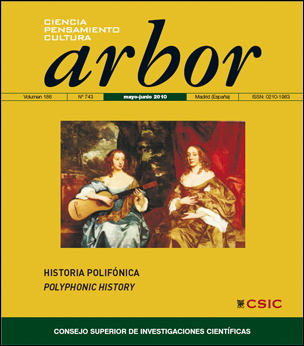Violación y trauma desde una perspectiva histórica
DOI:
https://doi.org/10.3989/arbor.2010.743n1205Palabras clave:
Trauma, violación, violencia sexualResumen
El trauma no constituye una forma universal de expresión de los efectos de un “suceso desagradable” sino que es construido socialmente. En el caso de la violación, el trauma psicológico es una forma relativamente reciente de conceptualizar las consecuencias de la agresión. En este artículo se examina el desarrollo de la noción de trauma en manuales psiquiátricos, legales y forenses, a propósito de las víctimas de violación, y se investigan las razones para su relativamente reciente puesta en práctica.
Descargas
Citas
Abrahamsen, David (1960): The Psychology of Crime, New York, Columbia University Press.
Anon (1848): “Fright a Frequent Cause of Insanity, and Sometimes a Cure”, American Journal of Insanity.
Bartley, Onesipherous W. (1815): A Treatise on Forensic Medicine or Medical Jurisprudence, Bristol, Barry and Son.
Bourke, Joanna (1996): Dismembering the Male: Men’s Bodies, Britain, and the Great War, London, Reaktion Books.
Bourke, Joanna (2007), Rape: A History from the 1860s to the Present, London, Virago.
Brown, Laura S. (1995): “Not Outside the Range: One Feminist Perspective on Psychic Trauma”, en Cathy Caruth (ed.), Trauma: Explorations in Memory, Baltimore, John Hopkins University Press.
Burgess, Ann Wolbert and Lynda Lytle Holmstrom (1974): “Rape Trauma Syndrome”, American Journal of Psychiatry.
Cambridge Department on Criminal Science (1957): Sexual Offences. A Report of the Cambridge Department of Criminal Science, London, Macmillan.
Chaddock, Charles Gilbert (1900): “Sexual Crimes”, en Allen McLane Hamilton y Lawrence Godkin (eds.), A System of Legal Medicine, vol. 2, 2nd edition, New York, E. B. Treat and Co.
Cowan, John (1869): The Science of a New Life, New York, Cowan and Co.
Dana, Charles Loomis (1898): Text-Book of Nervous Diseases and Psychiatry, 4th edition, London: J. & A. Churchill.
Duddle, M. (1991): “Emotional Sequelae of Sexual Assault”, Journal of the Royal Society of Medicine, vol. 84.
Erichsen, John Eric (1875): On Concussion of the Spine, Nervous Shock, and Other Obscure Injuries of the Nervous System in Their Clinical and Medico-Legal Aspects, London, Longman, Green and Co.
Erichsen, John Eric (1866): On Railway and Other Injuries of the Nervous System, London, Walton and Maberly.
Galllichan, Walter P. (1928): Sexual Apathy and Coldness in Women, Boston, Stratford.
Janet, Pierre (1889): L’Automatisme psychologique, Paris, Evreux.
Jensen, Reynold A. (1947): “The Importance of the Emotional Factor in the Convulsive Disorders of Childhood”, American Journal of Psychiatry.
Kardiner, Abram (1941): The Traumatic Neuroses of War, New York, Paul B. Hoeber. doi:10.1037/10581-000
McGuire, L. S. and Michael Stern (1976): “Survey Incidence of and Physicians’ Attitudes Toward Sexual Assault”, Public Health Reports, vol. 91.
Mann, J. Dixon (1898): Forensic Medicine and Toxicology, 2nd edition, London, Charles Griffith and Co.
Mardorossian, Carine M. (2002): “Toward a New Feminist Theory of Rape”, Signs: Journal of Women in Culture and Society, vol. 27.
Melanson, Joan (1994): “Psychiatrist’s Release of Confidential Information Causes Controversy in Halifax”, Canadian Medical Association Journal, vol. 150.
Micael, Mark S. (2001): “Jean-Martin Charcot and les névroses traumatiques: From Medicine to Culture in French Trauma Theory of the Late Nineteenth Century”, en Mark S. Micale y Paul Lerner (eds.), Traumatic Pasts: History, Psychiatry, and Trauma in the Modern Age, 1870-1930, Cambridge, Cambridge University Press.
Mills, Charles K. (1909): “Hysteria, What It Is and What It Is Not”, American Journal of Psychiatry.
Napheys, George Henry (1884): The Transmission of Life. Counsels on the Nature and Hygiene of the Masculine Functions, Toronto, J. S. Robertson.
Northcote, Hugh (1906): Christianity and Sex Problems, Philadelphia, F. A. David Co.
Ogston, Francis (1878): Lectures in Medical Jurisprudence, London, J. & A. Churchill.
Paris, John Ayrton y J. S. M. Fonblanque (1823): Medical Jurisprudence, London, Phillips, 1823.
Radzinowicz, L. (1957): Sexual Offences. A Report of the Cambridge Department of Criminal Science, London, Macmillan.
Root, Irving Wendell Ogden, y Wayne Scott (1974): “The Medical Examination of Alleged Rape”, The Western Journal of Medicine, vol. 120.
Smith, Sydney (1925): Forensic Medicine. A Text-Book for Students and Practitioners, London, J. & A. Churchill.
Stockham, Alice B. (1889): Tokology. A Book for Every Woman, Chicago, The Author.
Stone, Abraham and Lena Levine (1950- 51): “Group Therapy in Sexual Maladjustment”, American Journal of Psychiatry.
Storer, Horatio R. (1868): “The Law of Rape”, The Quarterly Journal of Psychological Medicine and Medical Jurisprudent, vol. 2.
Sutherland, Sandra and Donald J. Scherl (1970): “Patterns of Response Among Victims of Rape”, American Journal of Orthopsychiatry.
Tardieu, Ambroise (1878): Étude medicolégale sur les attentats aux moeurs, Paris, J. B. Bailliére et Fils.
Taylor, Alfred Swaine (1861): Medical Jurisprudence, 12th edition, London, The Author.
Terry, Gladys C. (1929): “A Study in Psycho- Dynamic Patterns”, American Journal of Psychiatry.
Zuspan, Frederick P. (1974): “Alleged Rape: An Invitational Symposium”, The Journal of Reproductive Medicine, vol. 12.
Descargas
Publicado
Cómo citar
Número
Sección
Licencia
Derechos de autor 2010 Consejo Superior de Investigaciones Científicas (CSIC)

Esta obra está bajo una licencia internacional Creative Commons Atribución 4.0.
© CSIC. Los originales publicados en las ediciones impresa y electrónica de esta Revista son propiedad del Consejo Superior de Investigaciones Científicas, siendo necesario citar la procedencia en cualquier reproducción parcial o total.
Salvo indicación contraria, todos los contenidos de la edición electrónica se distribuyen bajo una licencia de uso y distribución “Creative Commons Reconocimiento 4.0 Internacional ” (CC BY 4.0). Consulte la versión informativa y el texto legal de la licencia. Esta circunstancia ha de hacerse constar expresamente de esta forma cuando sea necesario.
No se autoriza el depósito en repositorios, páginas web personales o similares de cualquier otra versión distinta a la publicada por el editor.














